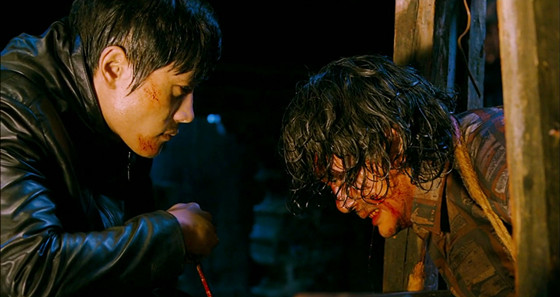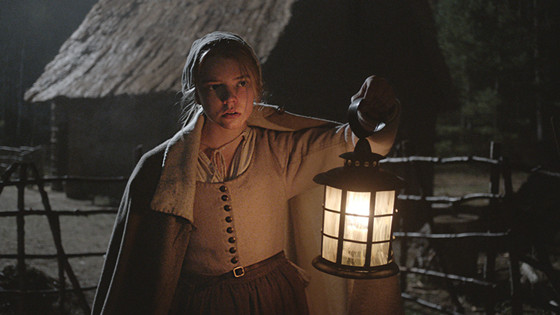5. I Saw the Devil (2010)

Have you heard, seen, or are already familiar with the expression of wishing to inflict pain on those that perform vile acts? Grotesque murders. Graphic torture. Cannibalism. Sociopaths, and even comedy, revenge thriller I Saw the Devil goes to great lengths in order to illustrate how revolting and self-destructive is self-claim to violence and sadism.
In contrast to the suggestive power of other entries in this list, I Saw the Devil exerts its dominion in grizzly, morbidly detailed scenes – the sound of a hammer crushing a skull, or a screwdriver piercing a face cheek-to-cheek – in order to psychologically assault viewers to question their own sympathy for the characters in this morally blurred cat-and-mouse game.
From genre-versatile South Korean director Kim Jee-woon, I Saw the Devil centers on NIS agent Kim Soo-hyun (Lee Byung-hun), who undertakes a quest for revenge by obsessively stalking and methodically torturing the manic sociopath Jang Kyung-chul (Choi Min-sik), who brutally murdered his pregnant wife.
By tailoring Soo-hyun as the quintessential avenger – the resourceful and expertly skilled martial artist with “every reason” to exact revenge – Jee-woon ironically taunts viewers to enjoy the graphic violence in order to underline not only the futility, but the permanent spiritual weight wrought by violence. In the fashion of the late Wes Craven’s The Last House on the Left, I Saw the Devil brings into question: “what gives the right to kill and inflict pain?,” hence, who or what is the eponymous “Devil.”
Mirroring the sadism throughout the film, I Saw the Devil showcases gorgeous cinematography in its most violent sequences; lush reds and blues popping from the pitch-black background. Despite its repetitive premise and action thriller conventions, it is its fearless exposition of dreadful violence and trajectory from tragic hero to out-and-out sadist, which elevates I Saw the Devil to horror glory.
4. Get Out (2017)

Similar to the supernatural allegories to real life horrors in It Follows and The Babadook, Jordan Peele’s genre hybrid debut film Get Out seamlessly blends horror and hilarity to fearlessly expose the racism and cultural appropriation lying underneath post-Obama America. However, it is not the outspoken loathsome racism Peele is interested in denouncing, but the often-overlooked misconceptions, micro-aggressions, and secrecy that often lurk in the interracial black-white interactions.
It is through innovative horror infused social commentary, where Peele’s brilliance as a director stand out the most, his ability to create a sense of uneasiness, a menacing aura behind seemingly trivial interactions such as the white hosts’ courtesy and eagerness to impress their daughter’s black boyfriend and protagonist Chris (Daniel Kaluuya).
Compared to recent art horror films Raw and It Comes at Night, Get Out seems to profit the most from its genre-dexterity, which under Peele’s direction, turned out to be the freshest horror films to hit mainstream audiences in recent years. It moves freely from comedy, epitomized in the far-fetched conspiracy theorist TSA agent and Chris friend Rod (played by Lil Rel Howery) to the otherworldly, warped art-house “Under the Skin-esque” sequences of Chris falling in a hypnotic abyss, to a bloody gore match similar to those in the work of Adam Winguard and Ti West.
In the same vein of the inner conspiracy, man vs society motif of films such as The Stepford Wives and Eyes Wide Shut, Get Out follows the up-and-coming photographer Chris, who despite being wary at the prospect of racial discrimination, accepts the invitation of his five-month white girlfriend Rose (Allison Williams) to visit her parents (both Bradley Whitford and Catherine Keener in great performances) at their ominous estate.
Chris’ suspicion is further aroused by the unnerving and erratic behavior of the family’s help: housekeeper Georgina (Betty Gabriel) and groundskeeper Walter (Marcus Henderson). As the clues keep piling up and the director provokes viewers to question what is really going on with Chris and his milieu, Peele steadily builds tension until its breaking point, in which Get Out unleashes its Blumhouse feature quality, ridiculously inventive all-out violence.
3. The Witch (2015)

Robert Eggers’ The Witch finds its greatest achievement in its masterfully crafted atmosphere, which has a disquieting, unnerving and menacing presence throughout the film. Eggers’ folk tale about an exiled Puritan family on the verge of self-destruction showcases the director’s brilliant calibration of cinematography, score, costume and production design in order to assemble a supernatural horror film whose deeply rooted psychological ambiguity is only matched and literalized through its meticulously detailed, Andrew Wyath painting impressionable, 17th century New England setting.
Excommunicated from a Puritan plantation and settlement, the family’s patriarch William (Ralph Ineson) decides to move away from the community, with his wife and five children, to build a farm in a secluded forest. However, unexplained supernatural occurrences such as the twin siblings’ claim that their goat, Black Philip, speaks to them and the sudden disappearance of their new born child Samuel, begin to take place in the farm, throwing the family in a crisis of faith.
Most of them, prominently the neurotic mother Katherine (Kate Dickie) blame their eldest pubescent daughter Thomasin (Anya Taylor-Joy) for the strange occurrences. Thomasin, who is the voice of consciousness against her parents’ rigid morality and blind order, gradually becomes interested in the pleasures outside the Puritan doctrine, which inevitably lead to the family’s undoing.
Essentially a morality play, The Witch is a portrait of a family in a state of emotional disintegration as they witness the futility of their spiritual conviction against unknown horrors. Expanding on the idea of dehumanization of films such as The Crucible, The Shining, and The Exorcist, Eggers employs the period setting – the backdrop for the flourishing span of diseases and starvation, as well as the witch hunts – as a microcosm of humankind’s inevitable depravation at the face of spiritual despair.
2. The Wailing (2016)

A large scale mysterious disease. Shamanistic rituals. A deer-eating naked Japanese man with fiery eyes and an ever-growing pile of corpses. South Korean director Na Hong-jin’s The Wailing might be oftentimes nonsensical, especially as a detective genre film, but it thrives as a supernatural horror/demonic possession tale that is not only unpredictable, but also an enjoyable comedy of terrors.
The Wailing takes place in a rural Korean village and follows Jong-gu (Kwak Do-won), a bumbling and hasty cop who is called to a scene to find the despondent killer – skin covered in gruesome boils and sores – who is husband and father to the two morbidly slashed victims. As similar cases keep turning up, villagers attribute the murders to an unidentified illness, whereas rumor has it that a mysterious Japanese man, the “Jap,” who has recently taken residence in the woods beyond the village’s outskirts is responsible for the events (hint to the Japanese colonialism, and the effect it had on the Korean mindset).
Being haunted by hyper-realistic visions of the “Jap” and having his daughter (Kim Hwan-hee) succumb to the illness, an impulsive Jong-gu takes matters into his own hands and decides to hire a shaman to cure her affliction as well as confront the ominous foreigner.
Na is successful in enthralling viewers for the film’s lengthy 156-minute duration by orchestrating scenes like long setpieces, meticulously composed and edited to gather as much dramatic build-up as possible. During its last half hour, The Wailing abandons its logic and emotional center-point to become a philosophical high-tension whodunit, deliberately leaving it to the viewer to try to decipher which is the real threat.
Similar, yet morally antithetical to its opening excerpt from the Bible, in which Jesus asks of his disciple, “Touch me and see, for a spirit does not have flesh and bones, as you see I have” (Luke 24:38), The Wailing taunts the soon-to-be victims to peek behind the curtain, only to sardonically laugh at their sign of helplessness.
1. It Follows (2014)

If the 2013 horror film scene was characterized by high grossing films that effectively executed the genre’s conventions, such as The Conjuring and Fede Alvarez’s Evil Dead, then 2014 was distinguished for smaller, subtler and more thematically innovative films that proposed new possibilities for the genre, some of these include The Babadook, A Girl Walks Home Alone at Night, and the more eyebrow-raising premise, It Follows.
David Robert Mitchell’s It Follows centers on 19-year old Jay (Maika Monroe), who after a sexual encounter with her sketchy boyfriend Hugh (Jake Weary), she is tied to a chair by the latter who reveals to Jay he has transferred an entity to her through intercourse. This shapeless monster, who assumes the appearance of any person in order to physically approach and kill the person carrying the disease, the only person to which it is visible. The only way for Jay to free herself from the mysterious entity’s persecutions, is to pass to someone else through sexual intercourse.
Although the logistics of who gets to be followed might lead some to assume the film is a metaphor for sexually transmitted diseases, It Follows is an allegorical portrait of teenage confusion towards the inevitability of adulthood, and therefore the confrontation with mortality. Sexual intercourse, as a rite of passage, is neither condemning (as some might come to expect) or self-fulfilling in the film’s context, but rather, it comes as a self-realization, a “wake-up call” that tells that nothing changes and never will.
As Yara, the teenager obsessed with Dostoyevsky’s The Idiot quotes, “your soul will leave your body and you will no longer be a person, and that this is certain. The worst thing is that it is certain.” As the title suggests, It Follows is about the internalization of mortality, which just as the shapeshifting entity’s unpredictable attacks, might arrive at any time, but it always does.
It Follows stands among the horror films in recent memory that are visually gorgeous. It underscores its poetic, cool hued, captivating production designed compositions with an eerie soundtrack by Disasterpiece.
Despite its shortcomings in a rather anti-climactic second half, particularly the final confrontation at a public pool and a narrative digression focused on Daniel Zovatto’s bad boy character Greg, Mitchell is successful in crafting a highly symbolic film whose horrors do not rely on gore or jump scares, but its allusions to real life horrors. Whether it would be a naked old man standing on a rooftop or a seemingly eyeless tall stranger casually stepping inside a bedroom, It Follows draws from a primal, inherent consternation towards that which is beyond understanding.
Honorable mentions: The Loved Ones (2012), Inside (2007), Drag Me to Hell (2009), Green Room (2016), Berberian Sound Studio (2012)